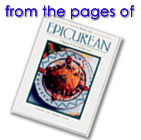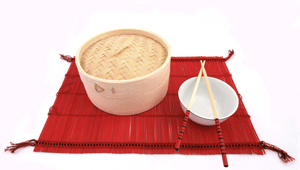
 |
|||||
|
|
|
|
|
|
|
The Cantonese ConnectionThe Waning of One of the World's Great CuisinesBy Ronald Mar |
|
 In the late eighties, local San Francisco media predicted the dawning of a renaissance for Hong Kong style Chinese food, and that this nouvelle Cantonese cuisine would become the next dining craze of the Bay Area. At that time, five major Hong Kong restaurants debuted their first U.S. branches in the Bay Area. In contrast with the existing Chinese eateries in the U.S., these major Hong Kong restaurants were professional operations that featured exquisite cooking, business-like management and modernized customer service. An influx of chefs and cooks soon followed, and they opened up a multitude of smaller restaurants that also served the Hong Kong style Chinese food. These restaurants and chefs succeeded in giving a new scope to Chinese food in the U.S., bringing new tastes and flavors to the American shores. The rapid expansion of the nouvelle Cantonese cuisine brought an excitement and craze, which soon engulfed New York and Los Angeles.
In the late eighties, local San Francisco media predicted the dawning of a renaissance for Hong Kong style Chinese food, and that this nouvelle Cantonese cuisine would become the next dining craze of the Bay Area. At that time, five major Hong Kong restaurants debuted their first U.S. branches in the Bay Area. In contrast with the existing Chinese eateries in the U.S., these major Hong Kong restaurants were professional operations that featured exquisite cooking, business-like management and modernized customer service. An influx of chefs and cooks soon followed, and they opened up a multitude of smaller restaurants that also served the Hong Kong style Chinese food. These restaurants and chefs succeeded in giving a new scope to Chinese food in the U.S., bringing new tastes and flavors to the American shores. The rapid expansion of the nouvelle Cantonese cuisine brought an excitement and craze, which soon engulfed New York and Los Angeles.
For well over 100 years Chinese immigrants had settled in the San Francisco Bay Area and in the U.S., establishing their native food and cuisine in this country. Chinese food was well recognized and appreciated in many areas. Nonetheless, thirty five years ago, I had quite a surprise while in the midst of a cross-country drive. I was passing through a mountainous area of Ohio looking for a quick bite to satisfy my evening hunger. As I searched, I unexpectedly found a Chinese restaurant amongst a small town gas station and several cottages. The owners were originally from Hong Kong, and had arrived in rural Ohio by way of relatives and friends. This discovery showed me that the Chinese people and food even survived in the most remote areas of the U.S. However, this remote Ohio restaurant, like most of the other Chinese restaurants in the U.S. at the time, was not truly authentic. They served some American dishes and "American chop suey'" recognized by many in the form of chicken chow mien or sweet and sour pork. Chop suey catered to the American crowd and was an altered version of Chinese cuisine. It inevitably developed a reputation as being cheap and of inferior quality when compared to French and Italian cuisine. Although several cities like San Francisco and New York had large Chinatowns, in the decades prior to the eighties, none of their Chinese restaurants were ever selected among the Top 100 restaurants in the U.S. Chop suey denigrated Chinese cuisine to a level of no respect and little sophistication. Even in the early seventies, while I wrote for a Los Angeles newspaper, a fellow food critic mistook haute Chinese cuisine as simply stir-fry, until I took him around to try the true flavors of Chinese cuisine. Before the introduction of the new Hong Kong food, Szechwan and Hunan cuisine of China were imported. Their spicy, hot taste pleased the American palate; however, their success was still limited. The real Chinese cuisine is much more complicated and refined. Among the hundreds of regional Chinese culinary arts, eight different divisions were identified, and Cantonese was often cited as the representative one. Since the end of the Manchu dynasty in 1911, Canton had been the mecca of Chinese gourmet tastes, and thus, Cantonese food was anointed the premier Chinese cuisine.
Nouvelle Cantonese cuisine started in Hong Kong when the city succeeded Canton to become the epicurean mecca. The style for superb Cantonese style food was slowly reformed, incorporating many flavors of the regional Chinese cuisine, such as Szechwan and Peking and their special ingredients into the Cantonese-style cooking. The influence of French, American and southeastern Asian cuisine was also exhibited. Hong Kong was a metropolitan, open-minded city in the last decades of this century, acting as a proverbial "melting pot" for international cultures. The local people quickly embraced this new refinement of Cantonese cooking. The nouvelle Cantonese cuisine transformed Chinese food in an analogous fashion to the way California cuisine revolutionized American food. By the late eighties, this Cantonese refinement had arrived in the U.S. and could be experienced by Americans for the first time.
|

Unfortunately, the much anticipated renaissance fizzled and did not really materialize. After just a few years, several major Hong Kong restaurants closed their U.S. branches. Also, the major Hong Kong Chow-Chiu and Hakka style restaurants did not arrive in the U.S. as predicted. When the major restaurants debuted, they were large-scale operations funded by corporations, so they looked for a larger clientele outside of Chinatown, often in suburbs like Millbrae and Emeryville in the Bay Area. First of all, the general American public could not really understand the food, and these Hong Kong restaurants could not meet their expected volume of business. Secondly, many of the special ingredients utilized by the nouvelle Cantonese chefs were unavailable in the U.S. or extremely expensive. The particular emphasis on herbs and live seafood was difficult to replicate here in the U.S., since different kinds of fishes and shellfish are used in Western cooking. Also, delicacies like shark fins, abalone and scallops are costly yet not truly appreciated by the American public. Thirdly, good Cantonese style Chinese food is not cheap; instead, the bill could be substantially higher than the prices charged by fine French and Italian establishments. This presented quite a change from the notoriously cheap American chop suey joints. Finally, a syndrome associated with monosodium glutamate (MSG) contributed yet another difficulty for the fledgling restaurants. In addition, despite the large influx of immigrants from Hong Kong to the U.S. due to Hong Kong's unstable political situation, many Chinese were unable to successfully transplant their businesses to American shores and eventually had to return to Asia. A pioneer of nouvelle Cantonese cuisine, Henry C. W. Wong, experienced this particular problem in the early 1990's when he attempted to open a Chinese restaurant in California. After six months of research and observation, he concluded that he was unable to undertake such an investment in the U.S. and returned to Asia. Wong was the general manager and proprietor of North Garden Seafood Restaurant in Hong Kong during the 1980's, which was widely recognized as the preeminent leader in nouvelle Chinese cuisine. His failure to establish a Chinese restaurant in the U.S. epitomized the difficulties experienced by the savvy efforts of other Chinese restaurateurs who attempted to enter the American market. For many Chinese immigrants, the option to return to Asia proved irresistible when the Asian economies boomed several years ago, making the restaurant business in Hong Kong more profitable than in the U.S. Several of the top Chinese chefs in the U.S. returned to Hong Kong for higher pay and better opportunities. On the bright side, the one trend that has caught on with Americans from this near-Renaissance is the "dim sum." This popular lunch-time meal featuring a wide assortment of dumplings, buns and other appetizers served with tea, has become a mini-craze in California. Of the remaining major Hong Kong restaurants here in the U.S., the Hong Kong Flower Lounge Seafood Restaurant and the Hong Kong Harbor Village Seafood Restaurant continue to carry on the legacy of nouvelle Cantonese cuisine. The Flower Lounge has been the more successful, operating four restaurants in Northern California, one in the Richmond District of San Francisco, two in Millbrae on the San Francisco peninsula, and the recently opened branch in Palo Alto. Their menu displays the wide variety of dishes that can be found in this refined Cantonese style of cooking. Slow simmered soups that take an entire day to prepare are one of Flower Lounge's signature specialties. Seasonal delights like the snake meat soup and the steamed Arctic snow mollusks are local favorites among the American-Chinese community. The Flower Lounge emphasizes live seafood as well, including steamed fish and quick boiled giant shrimp. Other specialties range from stir-fried frog legs to lamb shank clay pots. The assortment of barbecued meats and wild game such as the roasted squab, are a staple as well. Stir-fry fresh vegetables can be found in every meal. This list only represents the tip of the iceberg in terms of the wide array of dishes featured in nouvelle Cantonese cuisine in general and on Flower Lounge's menu specifically. Aside from Flower Lounge's success, the anticipated renaissance did not materialize in the Bay Area. However, efforts to expand continue. Las Vegas has been the latest hot spot, with several Hong Kong style restaurants opening in large hotels like Caesars Palace and Mirage. These restaurants with their top salary offers succeeded in recruiting some highly talented chefs from Hong Kong. At the same time, with the Asian economies in recession, the Asian clientele in Las Vegas has diminished and a few of the Hong Kong style restaurants have already suspended operations. Apparently, the hotels have decided that there is no longer a need to cater to this dwindling clientele. Upon closer observation, though, a more poignant point can be seen, and it symbolizes the predicament of nouvelle Cantonese cuisine in the U.S. As in Las Vegas, most Hong Kong style restaurants that feature his refined Cantonese cooking have yet to truly penetrate the American market. Perhaps, if Americans come to perceive nouvelle Cantonese cuisine in the same way they view California cuisine, it may one day be fully appreciated in the upper echelon of the world's finest cuisine. |
|
Copyright © 2008 Epicurean.com & Fezziwig Publishing Co. All rights reserved |